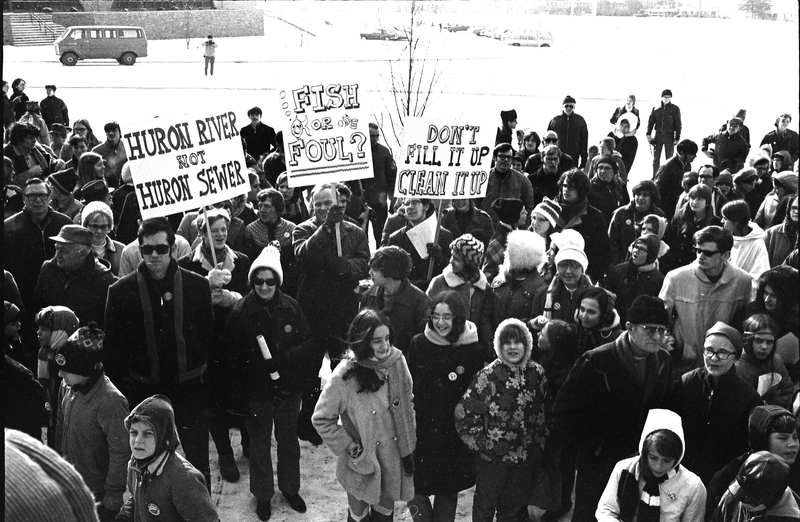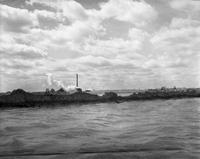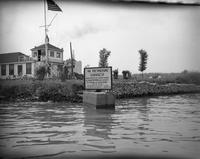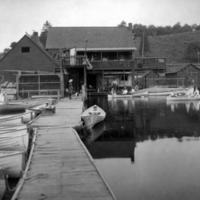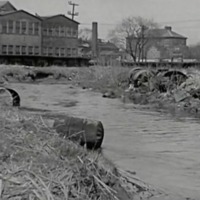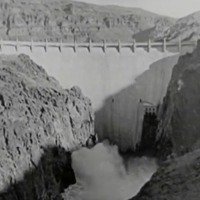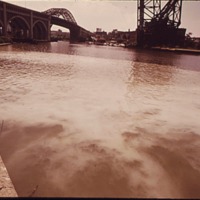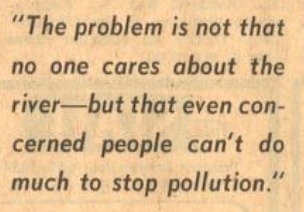The Huron River
In Michigan, student movements and activism groups gathered to guarantee their health, save their beautiful environment, secure a finite water supply, and protect their precious ecosystem.Organizations state-wide demanded that officials enact legislation to limit future toxic discharges from surrounding industry, and pushed for municipalities to build water treatment plants to reduce wastes that were already present. Health officials attempted to formally gather surveillance data on waste systems, and sought to examine the methods that were already in place. Citizens took it upon themselves to act: to protect the Lakes and Michigan's rivers; to write letters to legislators, newspapers and other government officials; to take action against known pollutors; to eliminate toxic household products that contributed to the high state-wide water pollution levels. In the aftermath of the Clean Water Act in 1972, citizens gathered state-wide to take action, protesting to spark a major water clean up. Locals harnessed passion into letters to the Michigan state Senator, Philip A. Hart, and channeled their energy into public campaigns to gather activists and make a change. Concerned individuals wrote these letters in an attempt to influence the Senator's key decisions regarding Michigan's water and budget for environmental quality. The Michigan public focused on the Huron River, particularly at community sites along the river.
In conjunction with the University of Michigan School of Public Health and a grant from the Huron River Watershed Council, University of Michigan's School of Natural Resources presented an informative awareness-raising video titled "Who Cares About the Huron River?" The video describes the path the Huron takes through Michigan's marshlands and lakes, and discusses how the River has historically met the demands of man and wildlife. The School of Natural Resources highlights how the beauty of the stream suffered, as waste from industry and municipalities concentrated along its shores and cities inadequately disposed of it. According to the video, "the people throughout the entire River Basin had acquired a sort of conscience, or citizens-of-the-basin attitude," which consisted of becoming accustomed and unalarmed by the Huron River becoming something similar to a sewer.
The Huron River
A similar story unfolds upon looking into rising activism regarding the Huron River. The Huron River spans 130 miles of Michigan, rising out of Oakland County, and passing through Portage Lake, Mill Creek, Dexter, Honey Creek, Ypsilanti and Ann Arbor to reach Lake Erie. Citizens along the River observed its degradation, and consequently took action to create change.
Portage Lake is an area of Michigan where cottages and lakeside homes crowd the circumference of lake. Septic tanks leaked human waste into lake, which ran into river. This type of pollution was also common in other areas with summer cottages as year-round homes. Mill Creek drains some of most fertile land in area. The area contributes to the Huron River’s burden by dumping in fertilizers from farms.
The municipality of Dexter served as one of the worst threats to the Huron River’s purity, dumping in 150,000 gallons of waste and sewage per day. Although this was significantly less than Ann Arbor's 14 million gallons of effluent per day, Dexter filtered out less than 40% of its sewage, and thus contributed much more pollution per capita to the Huron. The city was also heavily criticized for its method of sewage treatment. Treatment plants were required to add a chemical slough to the treatment process, which included sodium thiosulfate, a compound that neutralizes chlorine. Since treatment plants typically used chlorine to kill disease-causing bacteria, when sodium thiosulfate was added, chlorine was broken down and bacteria was allowed to enter the river. An example of the bacteria plaguing Dexter was typhoid. Organizations like the Water Resources Commission, discussed below, urged Dexter to correct its malpractice and improve its plant, however, officials had not taken action.
The Huron River runs through Honey Creek after passing Dexter, and is situated Northwest of Ann Arbor just above Barton Pond. Honey Creek drained waste from suburban ranch homes, accruing both agricultural fertilizers and human waste from septic fields. The accumulated waste had barely paused in septic fields before entering the Creek, when the fields were supposed to sift the waste down below water level to properly treat it. Researchers finally tested Honey Creek's water, putting the coliform bacteria count very high above average. This raises the pollution levels for Barton Pond as well, and scientists have deemed the coliform count over the maxmium acceptable level for swimming. Additionally, they determined that from Barton Pond downriver, the Huron River was off limits for “body contact."
In 1969, Ypsilanti was home to the Peninsular Paper Co., which was one of the major violators of the environment in Huron Valley. The company manufactured paper and printed cards, with sales increasing annually around the winter holidays. Peninsular openly released their industrial wastes directly into Lake Huron, yet claimed they were non-toxic and that they did not harm aquatic life directly.Eventually, the river water became too dirty to print clean, white christmas cards, and dirt particles roughened the paper's texture. Environmental councils, ones like the MWRC and HWRC, discovered that Peninsular's wastes weren't toxic, but interrupted the River’s food chain, and that the company also poured leftover wood fibers into river. These fibers clogged the gills of aquatic wildlife and altered the composition of the water, cutting food supply for fish.
“Peninsular would dump dyes in the river every time it made Christmas cards, changing the river’s color to a luxurient red or green.”In April of 1968, Peninsular agreed to start funneling its waste through a treatment plant; however, the plant only digested 90% of the company's pollutants. The untouched 10% of pollutants included the paper wood fibers. Ypsilanti thus turned its back on the river as a source for recreation and drinking supply, switching its water source to alternative wells, rivers and higher-quality functioning plants. But, when Ypsilanti does take water from Huron, it taps in at Geddes Pond just above the Ann Arbor treatment plant. (6)
Finally, Ann Arbor served as one of the main pollution sources in the Huron Basin in 1969. With an estimated 100,000 people flushing waste, Ann Arbor dumped about 14 million gallons of effluent into the Huron River per day. In Ann Arbor's treatment plant, 90% of the pollutants were again processed out of the water, so under optimal conditions, waste from 10,000 people was still going into river. When the Huron River flooded, the plant operated at only 40% efficiency, causing raw sewage to spew into river.
With a dense population, Ann Arbor collected a lot of waste from a lot of people. Ann Arbor storm sewers collected dirt and dust from various construction sites, oil from plentiful gas stations, pesticides from lawns and campuses, and salt from city streets in the winter. The storm drains emptied this accumulation of junk into river, causing a muddy complexion and angering citizens.
In 1969, Ann Arbor planned implementation of new devices to monitor impurities arising from local factories, research the pollutants effects and publicize pollution controls. The city's Department of Public Works recommended a new plan to remove 98% of sediments and 90% phosphates, and required $16 million for first 15 years of implementation. Along with conservationists in Ann Arbor demanding to upgade sewage treatment plants, Ann Arbor eventually hit a large money demand. The city looked to the state for financial aid, which had just passed a $325 million conservation bond, but none of it was guaranteed to go to Ann Arbor. The only solution to this issue was for Michigan to look outside of the state to federal funding. The city had high hopes since the federal government passed the Water Quality Act in 1965, which promised a 55% increase in donations to state and local projects aimed at improving water conditions. The government did not follow through as expected, though; since 1965, states have requested $1.5 bilion from the federal government, and Congress has only appropriated $214 million. Michigan, specifically, asked for $300 million, and only expected to receive $8-15 million. According to the University of Michigan's School of Natural Resources professor Spenser Havlic, it's an enormous struggle just to keep up with the pace of the present level of deterioration. This resulted in outrage toward the federal government from state and local officials.
Above Ann Arbor, the Huron River was used for farm irrigation and recreation, such as swimming, boating and fishing, in cities such as Kensington, Waterloo, Pinckney. These cities along the River worked together with th MWRC to measure coliform count, or the amount of bacteria in the water from human and animal excrement. For “body contact” activities, water coliform counts needed to be below 1000 units per 1/10 dL, while for “partial body contact” acitivities, like boatiing and fishing, coliform count needed to be below 5000 units.
ENACT Huron River Walk
Environmental Action for Survival, Inc. (ENACT), an environmental organization formed in 1970 at the U of M in Ann Arbor, was formed to constructively discuss and protest anti-pollution efforts and environmental issues impacting the country as well as to organize Earth-Day “teach-ins” on college campuses around the country. In addition to many rallies, assemblies, speeches and protests, ENACT lead a mass walk along the Huron River to protest the industrial pollution of and need for a clean-up of the Huron River.
James Tobin, the writer of "Earth Day Eve," a University of Michigan heritage project, wrote an account of the Huron River Walk.
"There were three or four big rallies, assemblies... and dozens of small workshops all over campus... On the final day, March 14, David Brower of the Friends of the Earth, arguably the leading figure in the entire environmental movement, led a mass walk along the Huron River… Several speakers warned that revolution, not a clean-up, was the only answer to industrial pollution.”
The walk attracted significant attention, prompting many to change the way they think about polluting their local waters. The crowd that walked along the River was comprised of not only U of M students and residents along the river, but also mass media news reporters and government officials like Senator Hart. (13).
Government and the Environment
The Water Quality Act
ENACT referred to the Water Quality Act [hyperlink] the most significant water pollution control legislation since the 1950s. According to Kohn & Spurr for The Michigan Daily in 1969, the demand for more, clean water inevitably costed money, which posed a dilemma. Conservationists in Ann Arbor requested an upgrade for its sewage treatment plan, and based on initial estimates, city council gauged the cost at $16 million. Many cities experienced similar financial burdens, so Senator Edmond Muskie of Maine, the Act's primary author, made sure to address this demand. The Act elevated the federal budget for grants to $150 million, thus facilitating arge construction programs at the local & state levels.
Due to its high population, Ann Arbor often battled between prioritizing high volume of water and high quality of water, a decision which could be averted if the federal government acted more freely with its checkbook. "That seem[ed] unlikely" to Kohn & Spurr, since Congress had passed the Water Quality Act in 1965 and had not followed through with its promises in the public's eyes. This is because the Water Quality Act promised a 55% donation from the federal government to state and local governments to be used as grants for with water-improvement projects, for example, the construction of treatment works. This guarantee prompted states to request roughly $1 billion from the federal government for their local projects. However, in 1969, Congress had only appropriated $214 million, and Kohn & Spurr predicted this number to only decrease even more over the upcoming years. Michigan had asked for more than $300 million, anticipating receiving only $8-15 million, which solidifies the idea that Ann Arbor needed "outside help if its treatment expansion is ever to mature beyond the drawing boards."
The Michigan Water Resources Commission
As reported by David Spurr for the Michigan Daily, it's not that people didn't care about the River's quality, but that concerned people couldn't do much to stop pollution. The primary fault, according to Spurr, traced back to weak, insufficient organizations, such as the Michigan Water Resources Commission (MWRC) - the institution responsible for enforcing anti-pollution laws. Along with the failure to implement guidelines, the MWRC took a long time to catch environmental offenders and to correct the pollution situations at hand.
The University of Michigan's School of Natural Resources Productiong "Who Cares About the Huron River?" features a clip from one of the MWRC meetings. The narrator of the film perfectly captures the goals of and motivations behind the Commission.
“Continuous effort by citizens is needed to improve publicly owned waste treatment facilities, and to assure proper operation of private septic tanks and drain fields. The council assists organizations such as the Huron Clinton Metropolitan Authority and the Michigan Water Resources Commission in determining water quality and quantity requirements for recreational areas, fish and wildlife, industrial and municipal water supply, waste disposal, and irrigation in the watershed. The lakes and streams provide excellent sites for a multitude of outdoor recreation activities. Opportunities for boating and canoeing can be increased if interested citizens express their demands and willingness to pay for more and better accessed facilities.”The Huron River Watershed Council
The MWRC created the Huron River Watershed Council (HRWC) in 1965 to protect the Huron River by influencing decisions made by various local agencies, businesses and individuals that impact the cleanliness of River. The HRWC aims to study, restore and protect the Huron River by informing communities and government agencies of both potential and real pollution issues that may negatively impact the River. It works with the MWRC to monitor and determine minimum watershed levels of stream flow, and rates industries on a scale from A-E about adequate control of discharge. (6) (7)
"Who Cares About the Huron River?" was made possible with a graant from the HRWC. The film discusses how disposal of inadequately treated wastes and runoff from both urban and agricultural land often bring about concentrated pollution. The narrator asks, "but who cares if the sewer pipes or improperly operated spetic takes run directly into the river, degrading its waters, covering its rocky bottom and banks with refuse, killing its fish and producing pools of litter and banks of decaying sludge? Who cares about the Huron River?" The narrator then answers this question by informing the viewer on the goals of the HRWC.
"Individual citizens, conservation groups, industrial leaders and municipalities care. They have supported the development of the Huron River Watershed Council, an intergovernmental body which advises local units of government on the most appropriate approach to sharing the river’s resources and preserving its beauty...The job is to get people to who aren't normally interested in water resources to become involved."Sources:
University of Michigan Audio-Visual Education Center, “Who Cares about the Huron River,” n.d. [1980s], Box 7, Media Resources Center (University of Michigan) Films and Videotapes, Bentley Historical Library, University of Michigan
Bentley Image Bank, Bentley Historical Library, University of Michigan
The Michigan Daily. Page image 8. June 1, 1978. Retrieved from https://digital.bentley.umich.edu/midaily/mdp.39015071754621/376. Accessed December 23, 2017
The Michigan Daily. Page image 36. April 13, 1984. Retrieved from https://digital.bentley.umich.edu/midaily/mdp.39015071754738/872. Accessed December 23, 2017
The Huron River. The Michigan Daily. Page image 14. Retrieved from https://digital.bentley.umich.edu/midaily/mdp.39015071754159/312. Accessed December 23, 2017
"History." Huron River Watershed Council. 2017. Accessed December 23, 2017. https://www.hrwc.org/about/history-of-hrwc/
"Saginaw River and Bay Area of Concern." EPA. October 23, 2017. Accessed December 23, 2017. https://www.epa.gov/saginaw-river-bay-aoc
Kohn, Howard; Spurr, David. "The Huron River." The Michigan Daily, Oct. 4, 1969.
Public Law 89-234, "Amendment to the Federal Water Pollution Control Act," October 2, 1965, https://www.gpo.gov/fdsys/pkg/STATUTE-79/pdf/STATUTE-79-Pg903.pdf
Barbara Reid, "Will We Ever Have Clean Water?," Environmental Action, March 20 1971, 3-5
Tobin, James. "Earth Day Eve." University of Michigan Heritage. 2017. Accessed December 27, 2017. http://heritage.umich.edu/stories/earth-day-eve/

